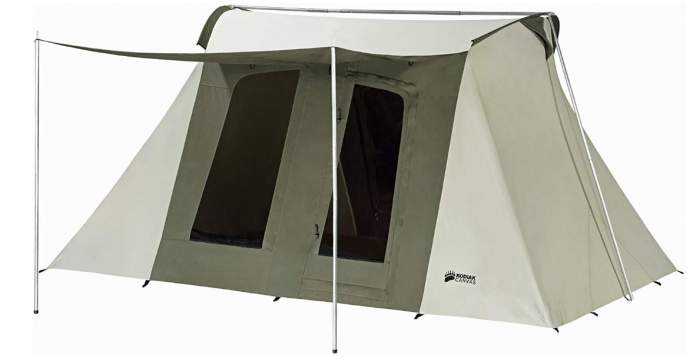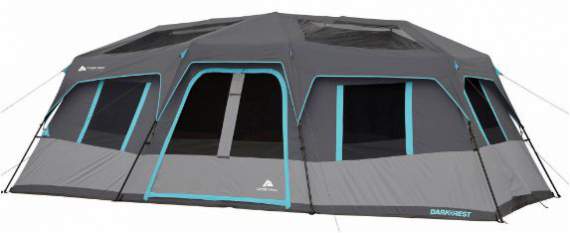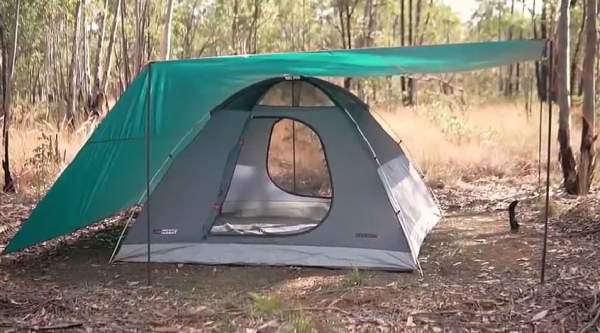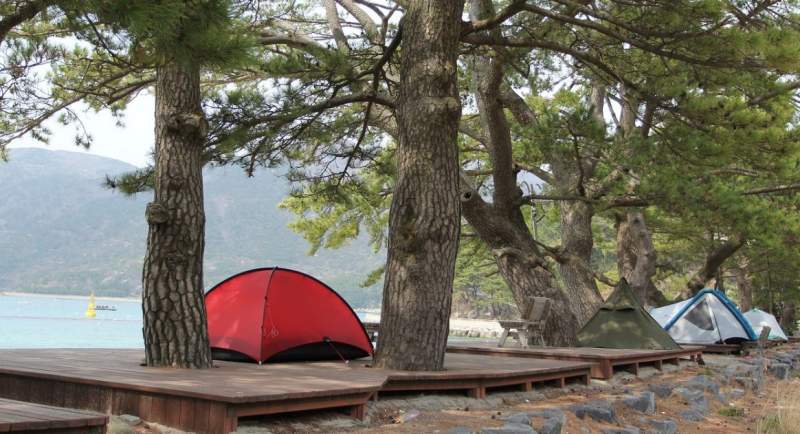If you want to know how to keep a tent cool in summer, this is the right text to read. There are several separate aspects to consider so keep reading.

There are at least three different elements in this, and they are given below by importance:
- Choosing the right tent.
- Go for a canvas or poly-cotton tent if you can afford it.
- There are insulated tents on the market. They are rare and very expensive.
- Find a dark-rest tent.
- Have a tent with lots of mesh (on the ceiling and on the windows).
- Have a tent with floor vents.
- Have a tent with fly vents.
- Choosing the right location. This is almost of the same importance as choosing the right tent.
- Some additional measures when you are already in the camp.
1. Choosing the right tent
So choosing the right tent is the most important step. Once you are in the camp, things cannot be changed if you come with an inappropriate tent. A few words more about the features mentioned above:
• Canvas or polycotton tents: These tents are closest to what you can call 4-season tents. They make the atmosphere in the tent a bit cooler, and a bit darker than most of the synthetic tents on the market. Most of them are breathable and this makes a lot of difference in comparison with synthetic tents.
You have a great selection of such canvas tents presented here in the site. These tents are usually very expensive but for all the good reasons. One great example is shown in the picture below.

• Insulated tents: Did you know that there are (currently just a few) insulated tents on the market? So they insulate from everything outside, and this implies both cold and hot weather, and they also give a bit of sound insulation. I should add here that all of them that are currently available are in fact polycotton tents.
• Dark rest tents, also known as dark room tents or lights-out tents: In this case you have a dark material used for the tent’s fly and walls. Some also reflect the sunlight, and this all together creates a cooler atmosphere in the tent. You can see our list with best dark-rest tents currently on the market. The example below is with closable ceiling mesh, a great option if you camp in the areas with lots of sand in the air.

• Tents with large mesh areas on the ceiling are always a great option. You have this in most of the cabin-style tents here in the site. The same holds for the mesh on windows. But you must close the windows if it is raining, and this is what makes the ceiling mesh so important.
• Tents with floor vents: Floor vents work great with the mentioned mesh on the ceiling and on the windows. This generates vertical air circulation and makes the atmosphere bearable. Floor vents are particularly essential in some of tunnel-type tents because many of them have solid windows.
• Tents with fly vents: Fly vents are essential to fight condensation. This works great in combination with floor vents. Note that these fly vents are a must on tents with a full-coverage fly. You have many dome-style tents in this group, but there are also some cabin tents with such a design. This is a must also in most of the mentioned tunnel tents.
Fly vents are less important if you have a cabin tent with a fly that covers only the ceiling, the air will find the way out in any case. The same holds for the dome-style tents with a brim or a small awning above the door. In such a design you have an extra pole that raises the fly and air can always escape.
2. Choosing the right location
There are several elements to consider here. These include:
-
- Pitching the tent in the shade. So if you have a chance to set the tent up under a large tree, similar to the picture below, you will do the best you can to stay cool in summer camping. Just make sure you know the direction in which the sun moves during the day so that your tent remains in the shade most of the time, or all the time if possible. This is incredibly effective, but as you know it is not always available.
-
Pitching the tent in the shade. - If you have a larger water area nearby, try to camp as close to it as possible because it is cooler near water. Also, if possible, point the tent’s main openings upstream with respect to breezes coming from the water.
- Make sure you know the direction of winds in the area where you are camping, and orient the tent with the door towards the wind. This will create natural airconditioning. Everything helps and this may make your camping bearable.
3. Additional measures for staying cool in a tent
This is again about the measures you take to stay cool in a tent when you are already in the camp.
• If possible, use some reflective sunshade or just a tarp above the tent. This is very similar to pitching the tent under the trees. With such a shade, you can stay in the tent even during the day. Make sure that the sunshade is positioned high above the tent. How high? The higher the better, as simple as that. In this case, air will flow freely and you will stay cool under the shade.
So this is something you do in the camp, but to apply this you have to bring such a sunshade with you. Note that there are tents designed with the fly that stays far above the tent, and the purpose is the same as having a sunshade. You can see this in the NTK Savannah GT 8 to 9 Person tent, see the picture below. But this all is useless if you camp in a very windy place.

• Make sure that all the vents are open during the day. The same holds for the panels on windows, just roll them down and keep the mesh alone.
• If the tent is with vestibules, roll them to the side and let the air circulate through the tent freely.
• It may be hot in the tent even during the night. This either because of the warm air or the warm ground. If so, then sleep off the ground, use a camping cot and you will feel the difference.
• I have seen many suggesting to disassemble the tent during the day. This makes sense but it is not so practical with all the stuff inside, and it is also annoying. But indeed, this may extend the lifespan of the tent because long exposure to direct sunlight is not good.
I do not think there is much more you can do unless you plan to use some cooling system in the tent. If you need something for desert conditions, check my tips about best tents for desert camping.
But please let me know if you think I have missed something important. There is a comment box below. Check also our text on how to choose a tent for camping in the rain. Thank you for reading and have a nice day.

Leave a Reply